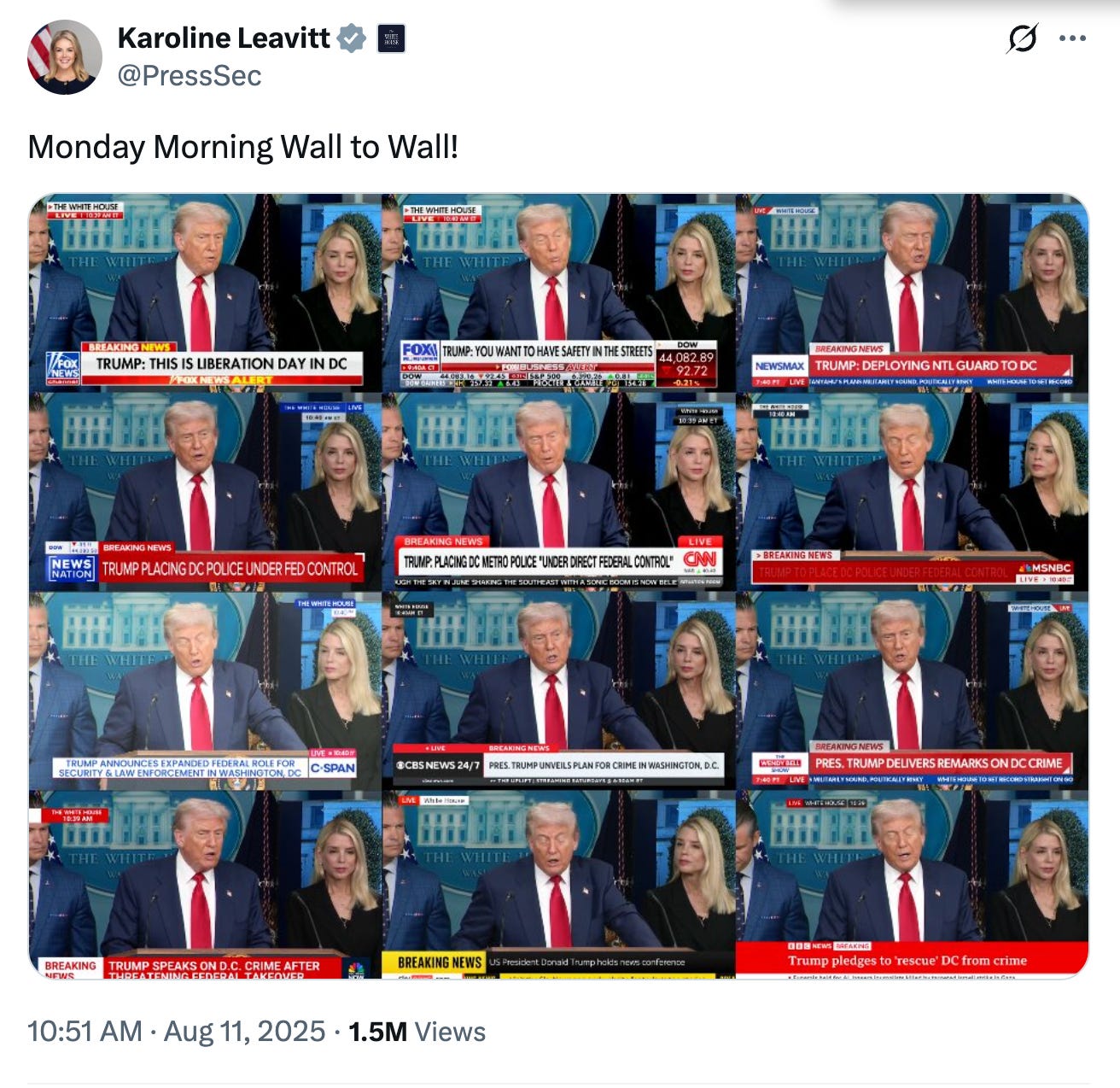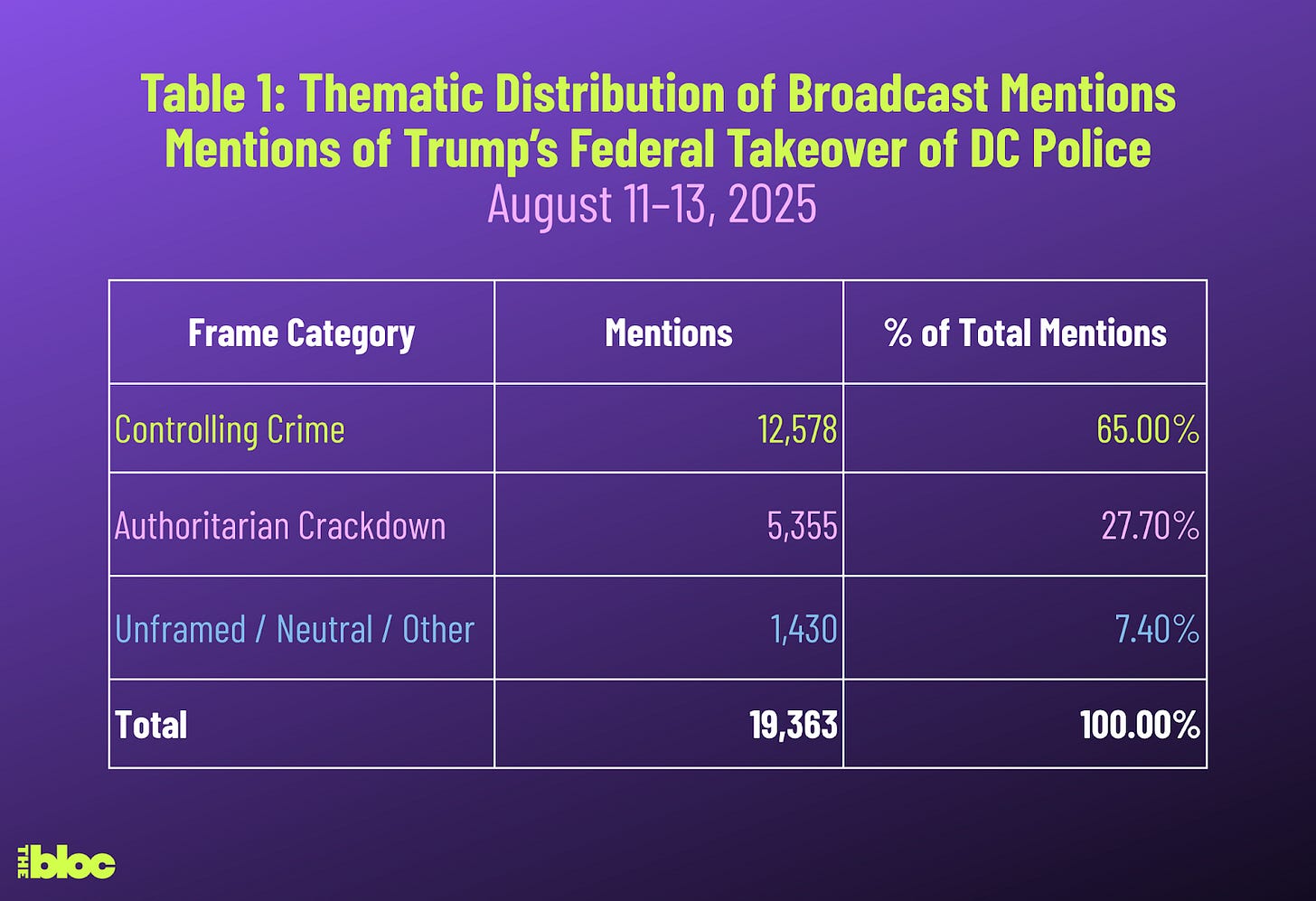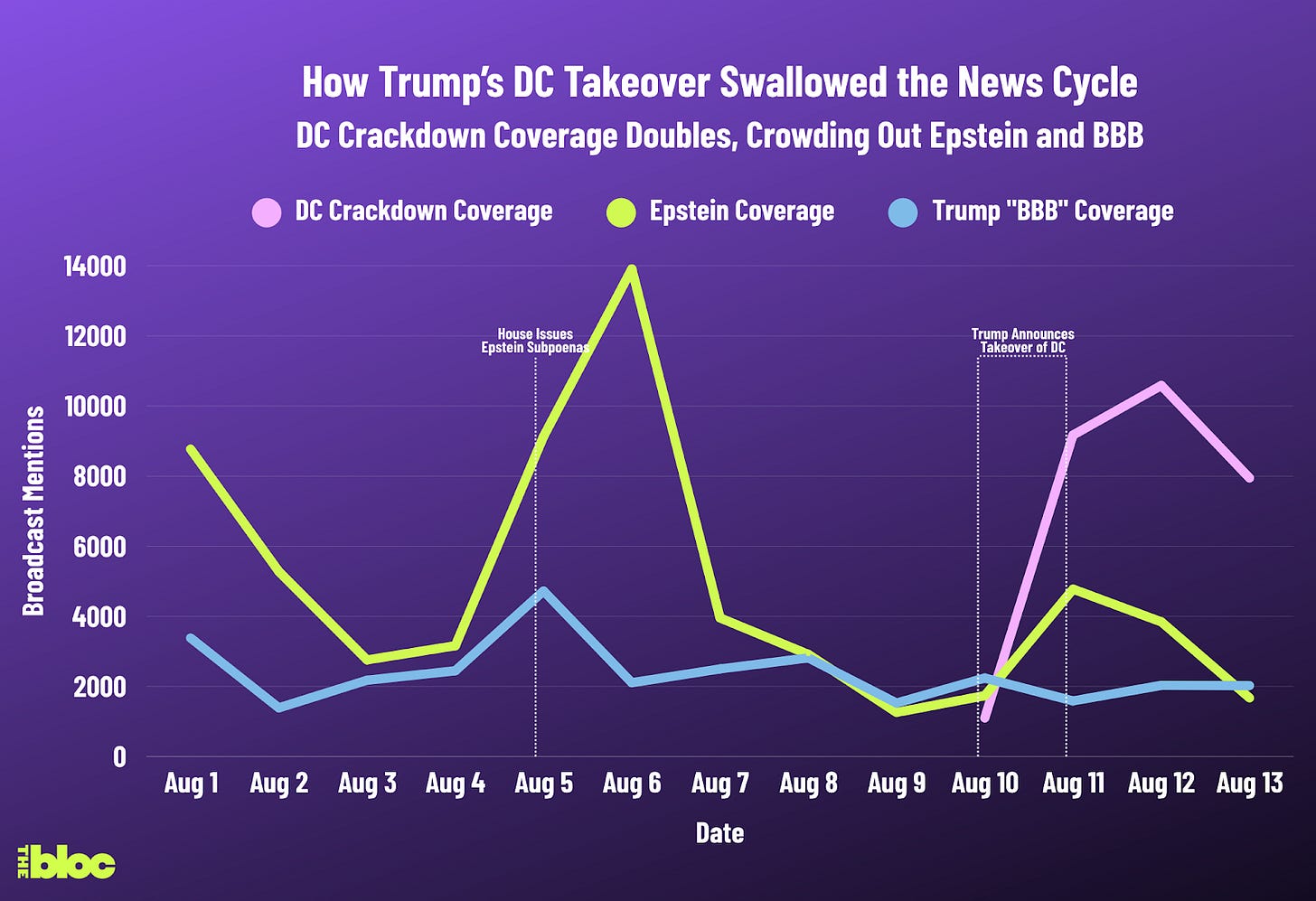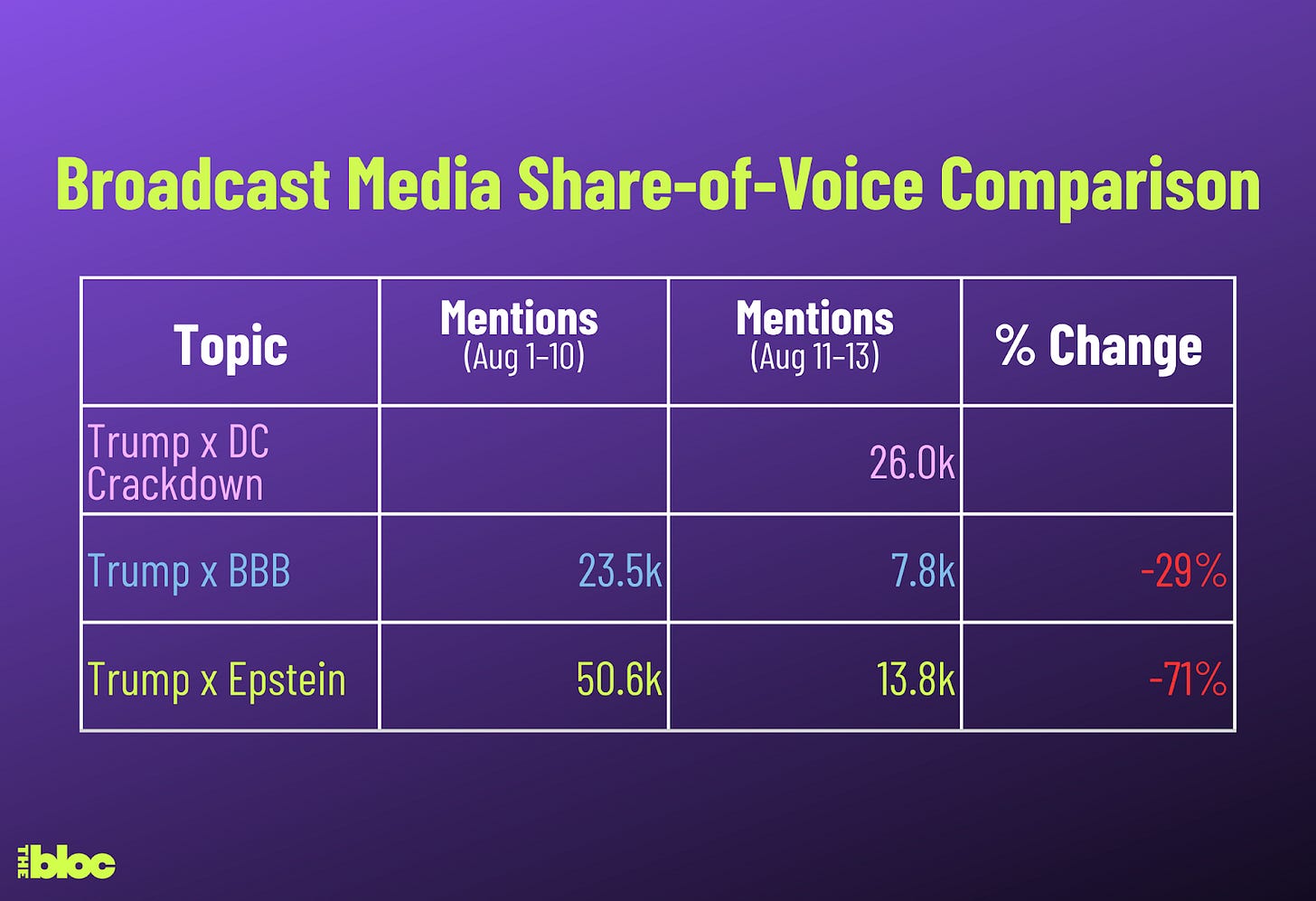The Distraction Playbook: How Trump’s DC Takeover Swallowed the News Cycle
Trump didn’t like what he was seeing on his TV screens these past few weeks, so he decided to change the story.
Executive Summary
President Trump didn’t like what he was seeing on his TV screens these past few weeks, so he decided to change the story.
President Donald Trump successfully hijacked the news cycle, using a staged, high-profile “crime crackdown” in Washington, D.C., to push coverage of the Epstein files and the unpopular Republican budget bill out of the spotlight. During the critical 72-hour window from August 11 to 13, nearly two-thirds of all broadcast mentions (65%) amplified and parroted Trump’s preferred frame of chaos, disorder, and crime, while only 27.7% characterized his actions as authoritarian overreach.
The authoritarian stunt was largely successful: mentions of the Epstein revelations dropped by 71% and budget bill coverage fell by 29%, replaced by imagery of federal troops patrolling city streets. This was not an accidental shift; it was a calculated diversion, and broadcast outlets largely allowed it to proceed unchallenged.
On August 11, Trump unilaterally placed the Metropolitan Police Department under federal control and deployed more than 800 National Guard troops into the streets of the nation’s capital—a civilian jurisdiction with no vote in Congress and a long history of disenfranchisement.
It was a choreography of power, designed to produce plenty of visuals on national TV that reinforced racist narratives of criminality while obscuring both the city’s declining crime rates and stories the president prefers would disappear.
This was not an isolated incident. Earlier this summer, the administration dispatched federal forces to Los Angeles in a limited deployment met with local resistance but minimal national scrutiny. The D.C. takeover marked a sharp escalation, bringing local police under federal control, suspending accountability measures, and eroding home rule. It signaled a president willing to extend such powers indefinitely--a vision of politics in which constitutional norms are disposable and Americans themselves are conscripted as props in a performance of state power.
Our review of 19,363 broadcast mentions found that, despite the unprecedented federal takeover of a local police force, outlets across the political spectrum rarely engaged in sustained scrutiny of its legality, historical precedent, or the racialized targeting at its core. When news coverage did include authoritarian framing—highlighting Trump’s overreach or the move’s use as a distraction—it was typically limited to brief quotes from local officials or short editorial asides, overshadowed by the frequent repetition of the administration’s talking points. This reflects not only individual editorial choices but a broader structural failure in the press to identify and describe democratic erosion when it is presented in the familiar language of “law and order” and reinforced by carefully staged displays of state power.
This report examines both the mechanics of that diversion and the effects of the media’s framing: two major accountability stories—the handling of the Epstein files and the Republican budget bill—were pushed aside, an extraordinary use of executive power was normalized, and the residents of Washington, D.C., most of them Black and Latino, were positioned as the backdrop for a display that served neither public safety nor democratic governance.
Methodology
This analysis is based on broadcast television news transcripts from August 11–13, 2025, the 72 hours following President Trump’s announcement of federal control over Washington, D.C.’s police force and the deployment of National Guard troops. The transcripts were drawn from a media monitoring platform tracking national networks (CNN, MSNBC, Fox News) and local affiliates in major U.S. markets. A total of 19,363 relevant mentions of Donald Trump were identified and analyzed for framing, using the following thematic categories:
Controlling Crime: Mentions that emphasized public safety, crime rates, civil unrest, or the need for aggressive policing. This category included segments that either supported or neutrally repeated Trump’s justification for the federal takeover. Examples include: “violent crime,” “crime wave,” “crime surge,” “violence,” “out of control,” “law and order,” “restore order.”
Authoritarian Distraction: Mentions that framed the events as an abuse of executive power or a threat to democratic norms. These often referenced historical parallels, Trump’s past use of force, or legal concerns about the militarization of domestic law enforcement. Examples include: “Authoritarian,” “militarization,” “fascist,” “abuse of power,” “overreach,” “power grab.”
Unframed / Neutral / Other: Mentions that were procedural, descriptive, or focused on tangential topics such as political polling, unrelated campaign activity, or pundit commentary that did not engage with the core issues.
Each mention was individually reviewed and assigned a single dominant frame based on the context and emphasis of the segment. When segments touched on multiple narratives, coders selected the frame most centrally conveyed by the anchor or guest. The sample includes both national shows and local broadcasts. Fox, CNN, and MSNBC shows were also analyzed separately for internal benchmarking but are included in this overall aggregate framing report.
Overview of Findings
Dominant Frames in Coverage
1. Authoritarian Overreach, Marginalized
A smaller portion of coverage—primarily from MSNBC and CNN primetime—framed Trump’s actions as undemocratic, describing the takeover as authoritarian in both tone and structure. These segments characterized the move as a unilateral assertion of federal control over a jurisdiction without congressional representation and with ongoing statehood efforts. They highlighted the lack of an immediate emergency to justify the action and drew comparisons to martial law and other displays of military authority.
Examples:
MSNBC, The Last Hour with Lawrence O’Donnell:
“Short of natural disasters and insurrections… every day that the President of the United States takes over a big city police force… is pretty remarkable.”CNN, The Lead with Jake Tapper:
“President Trump is taking control of the Washington, D.C. police force… activating 800 National Guard troops and threatening to bring in the U.S. military.”CNN, Anderson Cooper 360:
“This president did all of the above. Flanked by his Defense Secretary, Attorney General, and FBI Director, he announced he was taking federal control… and deploying troops to crack down on crime, bloodshed, bedlam, and squalor.”
This frame placed Trump’s actions in historical and legal context, highlighting not only their abnormality, but also the ease with which media, law enforcement institutions, and even some local leaders appeared to normalize them.
2. The Crime Crisis as Spectacle
A majority of right-leaning and several mainstream outlets echoed the administration’s preferred narrative: Washington, D.C., was a city in freefall. In this framing, Trump’s federal intervention appeared not only defensible but inevitable. The portrayal, however, diverged sharply from reality—violent crime in D.C. had declined 26% year-over-year. Despite this, coverage often relied on apocalyptic language, depicting the city as overrun by “roving mobs,” “bloodthirsty criminals,” and “drugged-out maniacs.”
The result was less a factual account than a made-for-television spectacle, presenting chaos as the central storyline and positioning Trump as the decisive figure capable of restoring order. This framing frequently drew on racialized tropes, emphasizing youth crime, unnamed “gangs,” and lawlessness in predominantly Black and brown neighborhoods, with little context or supporting data.
Examples:
Fox News, Hannity: “The president of the United States has declared himself crime fighter in chief, and he's taking over Washington's police force… Trump, most definitely, is trying to save D.C., trying to make it more safe.”
Fox News, Jesse Watters Primetime: “It's fascism to try to defend citizens in the streets of the capital… our murder rate in Washington, D.C., is worse than Bogotá, Colombia, and Mexico City.”
MSNBC, Morning Joe: “I’m not totally opposed to Trump’s National Guard move… crime remains rampant… None of us will walk more than three blocks after 8pm.”
CNN, The Situation Room with Wolf Blitzer (August 12, 2025): “But, as you know, there are plenty of neighborhoods here in Washington where they don't necessarily feel safe, especially at night.”
Even when data contradicted these portrayals, the coverage relied on emotionally resonant anecdotes and alarmist comparisons, leaving little space for critical scrutiny.
3. Selective Outrage and Moral Contradiction
A smaller subset of CNN coverage highlighted the contrast between Trump’s stated commitment to “law and order” and his earlier mass pardon of more than 1,200 January 6 rioters, including individuals who assaulted police officers.
This contradiction was presented not only as an inconsistency in principle but as part of a broader political strategy—using federal power against Black and brown communities in D.C. while protecting his own supporters from legal consequences.
A smaller subset of CNN coverage highlighted the contrast between Trump’s stated commitment to “law and order” and his earlier mass pardon of more than 1,200 January 6 rioters, including individuals who assaulted police officers.
This contradiction was presented not only as an inconsistency in principle but also as part of a broader political strategy—using federal power against Black and brown communities in D.C. while protecting his own supporters from legal consequences.
Example:
CNN, The Lead with Jake Tapper:
“While President Trump is clearly upset about crime in D.C., he did not appear to be upset earlier this year when he pardoned about 1,250 January 6th convicts, many of whom had beaten police officers.”
Though limited in airtime, this frame challenged viewers to reconcile the deployment of troops in a peaceful city with the excusal of violence against democratic institutions.
4. Elite Fear as Justification
One notable frame emerged indirectly, through implication rather than explicit argument. Several hosts, particularly on Watters Primetime and Morning Joe, acknowledged that some media figures and liberal professionals privately supported Trump’s punitive approach.
The underlying message was that fear—even among the well-connected—can be used to justify the use of state force. When hosts cited anecdotes about journalists avoiding walking after dark or suggested that “everyone in the [press] room knows it,” the effect was to normalize and subtly validate Trump’s actions, filtering authoritarian measures through the lens of class anxiety and shared social circles.
Examples:
Fox News, Jesse Watters Primetime:
“Journalists are secretly relieved… They’ve felt threatened. They live here.”MSNBC, Morning Joe:
“Even folks on our team are quietly supportive of the Guard. I’ve heard it all weekend.”
Distract. Distract. Distract: How Trump’s DC Crackdown Hijacked the Media Narrative
In the span of 72 hours, Donald Trump executed one of the most successful media diversions of his political career. Following widespread negative coverage of his ties to Jeffrey Epstein and backlash to his deeply unpopular GOP budget proposal Trump initiated a highly publicized federalization of DC’s police force and deployment of the National Guard—resulting in a near-total takeover of the news cycle.
Pre-Event Coverage (August 1–10)
In the 10 days prior to Trump’s announcement:
Trump & Epstein averaged 4,600 daily mentions, totaling 64,400 across major media outlets.
Trump’s GOP Budget (BBB) averaged 2,230 daily mentions, totaling 31,300.
Public polling from Data for Progress during this period showed that:
Epstein-linked stories were beginning to break through, particularly among swing voters and independents.
The GOP’s budget bill was widely unpopular right out of the gate, especially with low-income voters and seniors, but coverage had not yet saturated although it was building.
The Pivot (August 11–13)
Immediately after the announcement of Trump’s federalization of the DC police and National Guard:
Coverage of the DC crackdown exploded to 45,600 total mentions, with a peak of nearly 11,000 mentions on August 12.
At the same time, Epstein coverage dropped by 71%, falling from 4.6k daily mentions to under 1.4k, despite new documents surfacing that linked Trump more clearly to Epstein’s operations.
GOP budget bill coverage dropped 29%, from 3,150 daily mentions to 2,230, just as analysts and watchdog groups began digging into its most damaging provisions.
While the August congressional recess contributed to reduced baseline attention to both the Epstein revelations and the GOP budget bill, the magnitude and immediacy of the shift following the D.C. takeover announcement suggest a deliberate displacement effect, acknowledged by the White House Press Secretary herself. In the 72 hours after August 10, mentions of the crackdown rose by 132%, while Epstein coverage fell by 71% and budget coverage declined 29%—a swing too steep to be explained by seasonal patterns alone.
Trump “wagged the dog” successfully — escalating an authoritarian action that is both on shaky legal ground and alarming for democratic norms, but guaranteed to dominate headlines. The move functioned not only as a policy decision but also as a crisis communications intervention.
This wasn’t simply opportunism. The timing, the choreography, and the amplification of the D.C. crackdown through aligned media channels point to intentional narrative displacement. In July, a Reuters/Ipsos poll showed that nearly 70% of respondents believed the federal government was hiding details about Epstein’s clients. Just two weeks ago, Trump’s approval ratings hit their lowest point of the term. The shift of focus was intentional and devastatingly effective.
By the time the news cycle returned to Trump’s Epstein connections or the GOP budget proposal, the moment of public attention had passed. None of this is inevitable: it was the product of editorial choices. When a president manufactures a crisis the press, in their unique role in any viable, thriving democracy must find a way to produce coverage that isn’t instrumentalized to amplify the spectacle without scrutiny. They must confront inaccurate, fear-based anecdotes with verified data, and sustain coverage of key issues rather than allowing them to vanish in the shadow of staged political theater.












"How Trump’s DC Takeover Swallowed the News Cycle" You could write another one about how the assassination of Charlie Kirk buried the Holocaust news like the invasion of Gaza City, buried the anniversary of 9/11 and Israel's role in that, as well as news about efforts to override the U.S. Veto in the UN. "United for Peace" https://www.youtube.com/watch?v=CpZzkVfWRIE&t=187s
Amazing - major value add - will subscribe when I can, ty